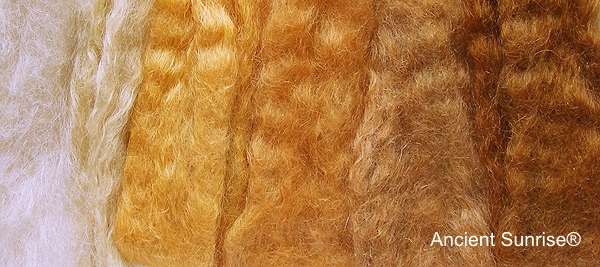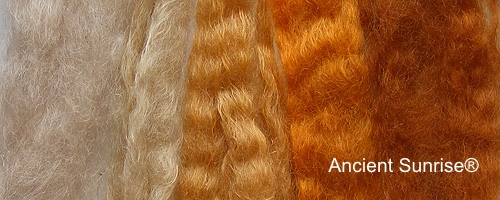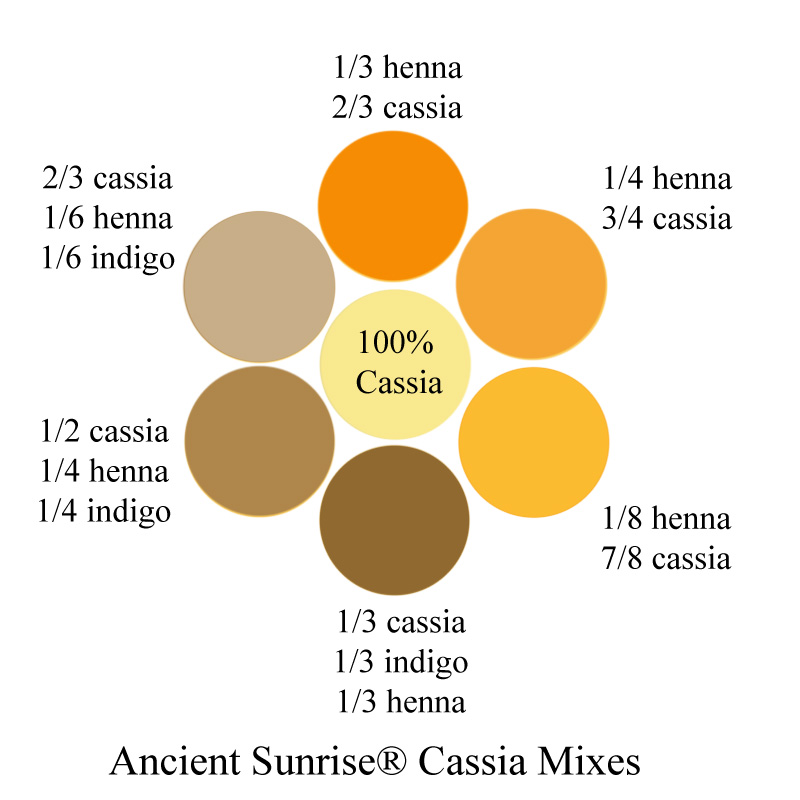
Henna dyes hair shades of red. Add indigo, and you’ll get brunettes, but what if you have gray, white, or light blonde hair and want to keep it that way? Mixes that have a higher amount of cassia, and a smaller amount of henna and indigo will help dye hair blonde. Tones that range from sun-kissed straw to deep, “dishwater” blonde are possible on lighter hair. These mixes are great for those who don’t want red, brown or black hair, and for those who wish to tint their grays to blend naturally with their root growth. This article will cover everything you might need to achieve your ideal blonde.

Cassia mixes dyed these mohair samples a range of blonde shades.
Cassia
Cassia auriculata is a plant dye powder that has similar benefits of cassia obovata. Clarity’s dye molecule, chrysophanic acid, is too weak to change hair color very much.
Cassia is sometimes incorrectly referred to as “neutral henna” or “colorless henna.” It is not henna, but it is used in a similar way. It needs to be dye-released with a mildly acidic liquid just as henna is, and it also provides hair with strength and shine.
This plant powder will not make dark hair lighter. All plant dye powders add color to the outer layers of the hair strand; none will lift the melanin contained within the hair’s cortex. This plant powder will act as a conditioner without altering the color.
Ancient Sunrise® no longer sells cassia obovata due to supply chain issues. We do sell Clarity Cassia, which is cassia auriculata. Read about cassia auriculata here: http://www.hennaforhair.com/faq/Clarity_cassia-auriculata.pdf
Choosing your Fruit Acid
Like henna, cassia’s color can be manipulated depending on a choice of fruit acid, when used with henna or henna and indigo. Fruit acid choices such as Ancient Sunrise® Copperberry and Ancient Sunrise® Kristalovino will bring out brighter tones. The Ancient Sunrise® Henna for Hair Blonde kit contains Ancient Sunrise® Clarity Cassia, Twilight Henna, Sudina Indigo, and Ancient Sunrise® Kristalovino Fruit Acid Powder.
Ancient Sunrise® Nightfall Rose and Ancient Sunrise® Amla powder will mute the brighter tones, allowing for more neutral, “wheat blonde” results depending on the amount of henna and indigo in the mix.
For richer color, greater permanence, and more control over warm and cool tones, one can increase or decrease the amounts of henna and indigo in a mix. The remainder of this article will discuss how to do this.
Adding Henna
The dye molecules from cassia are translucent, and less permanent than henna. Some find that cassia alone provides results that are too subtle and which fade over time. Adding a small amount of henna, a much more permanent dye, leads to warm blond results that do not fade.
Henna and cassia mixes will dye light hair a range of shades from strawberry blonde to bright, fiery orange. The more henna, the warmer and redder the results will be. For results that lean more toward blonde rather than copper, it is important to use a mix that contains a majority of cassia, and just a touch of henna.

The Ancient Sunrise® Henna for Hair kit in Sunshine contains 200g Ancient Sunrise® Clarity Cassia and 50g Ancient Sunrise® Rajasthani Twilight henna, or a 4:1 ratio of cassia and henna. This kit gives warm, strawberry blonde results on light hair. The Ancient Sunrise® Henna for Hair kit in Fire has equal parts Ancient Sunrise® Clarity Cassia and Ancient Sunrise® Rajasthani Monsoon henna for vivid copper-orange results.
Feel free to play around with ratios by purchasing samples of the kits, and samples of cassia and henna to test on hair collected from a hairbrush or recent hair cut, or on a 1” section of hair on your head.
Adding Henna and Indigo
Adding both henna and indigo to a cassia mix will allow for darker blondes, and neutral to cool blondes. Equal proportions of both henna and indigo in small quantities added to a larger amount of cassia will result in neutral-to-warm deeper blondes.
The Ancient Sunrise® Henna for Hair kit in Chai contains 200g Ancient Sunrise® Clarity Cassia, 50g Ancient Sunrise® Rajasthani Twilight, and 50g Ancient Sunrise® Sudina Indigo. It is a 4:1:1 ratio of cassia, henna, and indigo. Its fruit acid, Ancient Sunrise® Nightfall Rose, assists in adding ash tones. The Chai kit dyes light hair medium to deep blondes. It is a very popular choice for those who wish to blend their gray hair into warm highlights.
Those who want cooler toned blondes can experiment with adjusting their henna and indigo ratios. In a majority cassia mix, more indigo will help to neutralize warm tones from the henna and cassia, resulting in cool. Ash blondes. To keep results light, cassia should always make up the majority of the mix, or about 75% minimum. Indigo should not be more than three times the amount of henna. Too much indigo will cause results to have a violet tinge.

Just a few possibilities for mixing cassia, henna, and indigo, and the expected results when applied to light hair. Please note that 100% cassia will not give golden tones, this is what you can expect with the current Ancient Sunrise Blonde Kit.
An example mix for a cool, lighter blonde on gray hair could be 6 parts cassia, 1 part henna, and 2 parts indigo. Mixes using all three powders can be more complicated, as there are more factors to control. You can read Full Coverage: How to Achieve Neutral or Cool Tones to learn more about mixing cassia, henna, and indigo to achieve your perfect cool-toned color.
Remember that ratios should be based on dry powder weight. If you need help converting weight to teaspoon/tablespoon measurements, feel free to contact the experts at customer service.
Using a mix of cassia and indigo without henna is generally unadvised. Both dyes are less permanent without the presence of henna. In some cases, a cassia/indigo mix may be used to tone away warm tones in hair that has been hennaed already and is too red.
Final Tips
Cassia is particularly sensitive to hard water. A build-up of minerals will turn cassia-dyed hair from golden yellow to a murky brown or awkward gray. It is highly recommended to use Ancient Sunrise® Rainwash to clarify hair prior to dyeing, and periodically afterward.

Hair that is dyed with cassia will become dark when subjected to minerals. Use Ancient Sunrise® Rainwash Mineral Clarifying Treatment to keep hair light and bright.
Using Ancient Sunrise® Rainwash prior to dyeing will also ensure the best color results. Build-up may prevent adequate dye uptake, leading to weaker results.
As with any mix, it is better to start lighter and go darker. Many clients who are looking for blonde results specify that they want to stay as light as possible. For some, just a spoonful or two of henna and indigo for a full packet of cassia will be enough to achieve the desired results. Gradually deepening your results will be much simpler than unintentionally dyeing your hair too dark and trying to remove the color.
Conclusion
Hair that is dyed with natural plant dye powders doesn’t have to be red, brunette, or black. Blonde shades are great for those have have naturally light hair and want to keep it that way, and for those want to tint or brighten their gray hair without going too dark. Blonde mixes allow gray root growth to blend more easily into the length. Those who have used henna for hair products and wish to transition back to natural gray hair can use blonde mixes to do so.
It is important to keep in mind that cassia, henna, and indigo are all additive dyes, and cannot make the hair lighter. If one wishes to dye their naturally dark hair blonde with cassia, they can consider lightening their hair first, then dyeing the lightened result with a blonde mix. Remember to consult a professional stylist for lightening.
For all other questions, don’t hesitate to call, email, or chat with Customer Service at www.Mehandi.com.
Author: Rebecca Chou
Updated: Maria Moore Jan 2022

Thank you so much your information was very informative keep up the good work!! 👍 👌 👏 😊